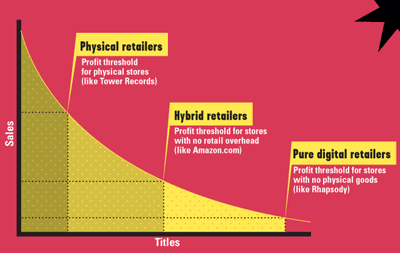When it comes to the World Wide Web, there have been many changes in the last decade. Just about anything can be accessed and purchased online. With websites like Netflix for films, Rhapsody for music, and Amazon for whatever else it is that you could be looking for, if you can think of it, you can find it.
This is referred to as the long tail. The long tail is a selling strategy that focuses on accommodating for particular niches. With this strategy, companies are selling larger amounts of different items in smaller quantities, compared to companies that are selling smaller amounts of popular items in large amounts.

Chris Anderson talks about the Pareto or the 80/20 rule. According to this rule only 20% of music, films, and books etc. will be hits, while the other 80% will miss. But according to Robbie Vann Adibo, the CEO of Ecast, actually 99% of everything sells because nearly everything is demand.
With everything being in demand, there are increases in independent production. Many people can now create their own media, and put it on the web. This is done for films also. There are many independent film makers, that make films and sell them to online movie stores.
All of these factors can be associated with infinite shelf space. Infinite shelf space can be helpful to both the consumer and producer. It beneficial to the consumer since it allows them to search through a wide array of selections that stores do not usually carry, since their space is limited. By browsing online, consumers are almost guaranteed to find exactly what they are looking for. It helps the producer by allowing them to get their work out more effectively and efficiently. With this happening, it should allow their sells to grow. And making money is what it is all about.
References
Anderson, Chris. (2004). "The Long Tail". WIRED Magazine, Issue 12.10. Retrieved from http://www.wired.com/wired/archive/12.10/tail.html?pg=2&topic=tail&topic_set=.
Anderson, Chris. (2004). "The Long Tail". WIRED Magazine, Issue 12.10. Retrieved from http://www.wired.com/wired/archive/12.10/tail.html?pg=2&topic=tail&topic_set=.
Anderson, Chris. (2006). "Identifying The Long Tail". [Video File]. Video Posted to
http://www.youtube.com/watch?v=0Yku0GTrcuw&feature=fvw.
http://www.youtube.com/watch?v=0Yku0GTrcuw&feature=fvw.
Photo:
http://www.aurorawdc.com/ci/000340.html

3 comments:
I like your blog layout.
I enjoyed reading your blog post. I do agree that everything is nearly in demand and this has allowed for so much independent production. There are so many products out there nowadays innovated by aspiring entrepreneurs. I definitely agree that 'making money is what it is all about' because many people are driven by incoming profits. Only the people who give interested people the choice to "buy" or "take for free" are the ones that don't really care for the money.
Good job!
So very pink!!
Good post. But, I think you should re-read Chris Anderson's article and review the section in his book about the 80/20 rule. The 80/20 rule is not about hits & misses. It simply states that 20% of products account for 80% of sales. Because of the Long Tail, that rule is being turned on it's head. No longer do the majority of sales come from such a small fraction of products. Now we see more items at the end of the tail selling quite a bit. In fact, more than half the books sold on Amazon are not sold in stores. So this large portion of sales are in fact the books that sell only a few copies. But, in total they sell more than the few top-selling books.
Post a Comment